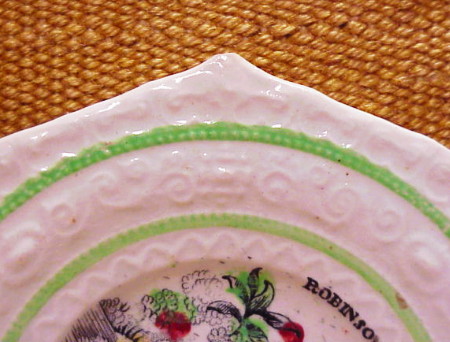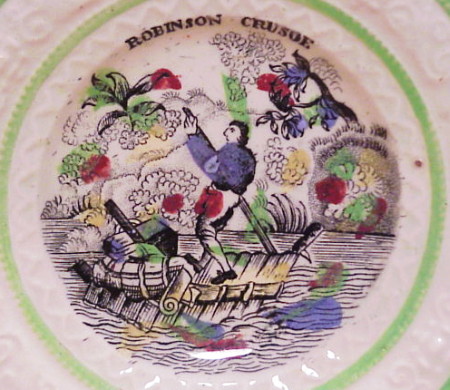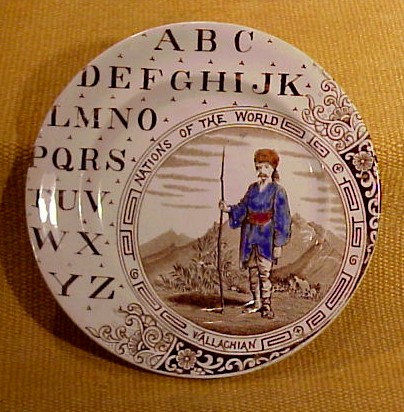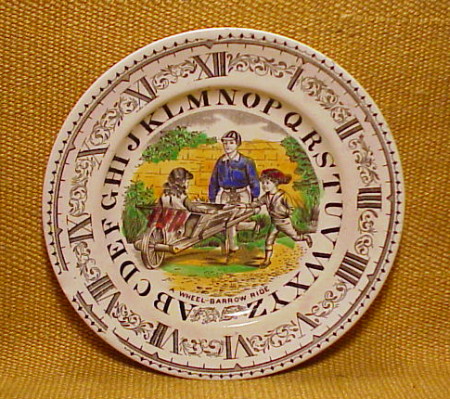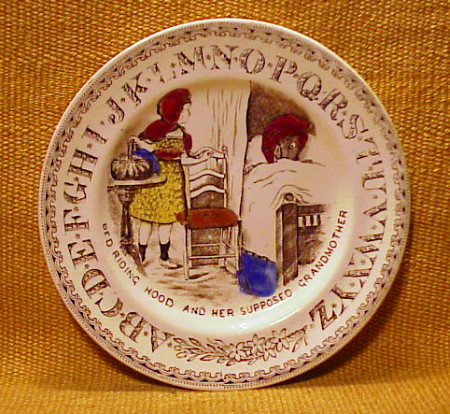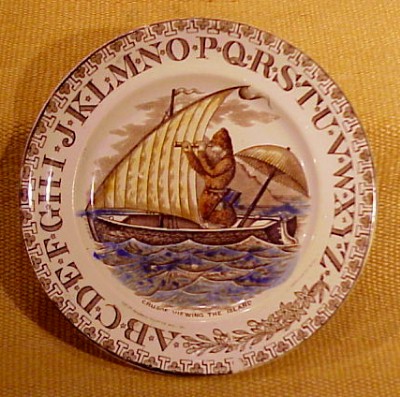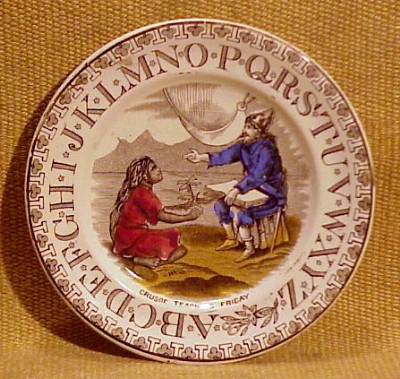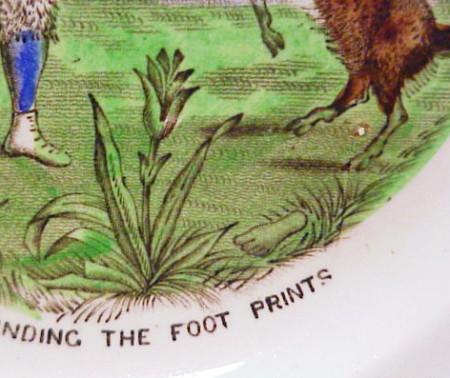Posted By: Tim
Posted on: 2012-05-03 12:35:24
Featured Item
Relief-Molded Parian Jug
Wellington Commemorative
While credit for the development of parian is obscured by the conflicting claims of several 1840's potteries, its advantage over the sandy textured unglazed porcelain previously used for figures and busts is obvious. Its surface, though unglazed, was pleasingly smooth to the touch and offered an elegant sheen to the sight. The 1846 Art Union Magazine expressed the universal enthusiasm: Parian, also called statuary porcelain "is scarcely inferior to marble as a material for art...The characteristic of the statuary porcelain is lustrous transparency, and in this it rivals the best specimens of alabaster." (1) It was named after the fine marble of the ancients; Wedgwood went further and called their version "Carrara." Potters, seeking at this time to lift the quality standards of British manufacture and of the public's taste, created galleries of decorative sculpture that, while not inexpensive, was within the grasp of the expanding middle class market. By 1851, with its proliferation at the Crystal Palace Exhibition, parian was well established. Its presence extended to tablewares as well as decorative objects. Parian gave a new polish and refinement to the relief decorated jugs that hitherto had appeared in heavier stoneware.
While we do not know the maker of our little parian milk jug, we can identify its subject and its serious intent. Though the relief profile had grown craggy since his dashing portraits by Goya and Lawrence, the features were well known to the public as those of Arthur Wellesley, First Duke of Wellington, the greatest hero to have survived the Napoleonic Wars. Our jug does not celebrate his military victories, but instead memorializes his death in 1852. Today few perhaps realize that Wellington's career stretched nearly forty years past the Battle of Waterloo.
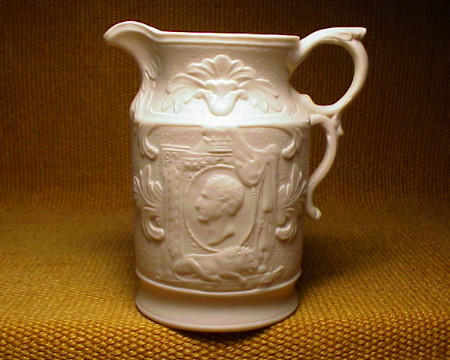
_f191x289_1336228258.jpg)
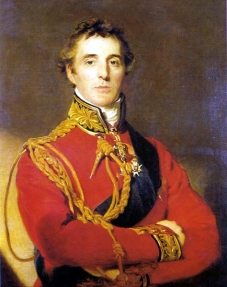
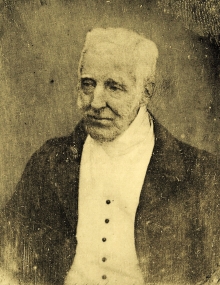
The hero's post war life was hardly free from conflict, however--perhaps giving a second meaning to his famous comment on the melancholy nature of "a battle won." He was involved in bitter conflicts over various reform movements, becoming personal enough to lead to duelling pistols in 1829. His time as PM was marked by public riots. Most sources agree that the nickname "Iron Duke" stems not from his military exploits, but from his decision to install iron shutters on his London residence Apsley House after losing too many windows to the rocks of protesters. In a more private arena, his second most famous quotation, "Publish and be damned," was provoked by the threatened publication of memoirs by his mistress Harriet Wilson.
Still, his was a hero's life filled with honors and tributes, including a grant from the nation for the purchase of the estate of Stratford Saye in Hampshire. Visitors today still find Apsley house filled with extraordinary gifts of porcelain, silver services and art works from his countrymen and allies, as well as from his defeated opponents. Particularly striking is the colossal nude statue of his enemy Napoleon as Mars that commands the stairwell. Commissioned by Napoleon from the sculptor Canova, it became a tribute gift from Louis XVIII, restored King of France. Almost equally startling is the giant nude Achilles cast in his honor from captured enemy cannons and installed at the nearby entrance of Hyde Park. On a smaller scale, numerous ceramic and medallion commemoratives depict the elder statesman as well as the hero of Trafalgar.

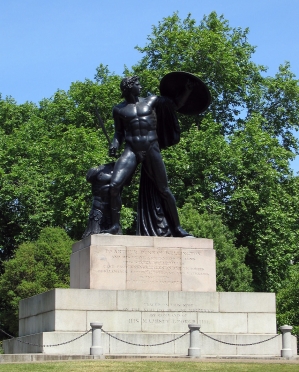
One of Wellington's most personal honors came late in his life when Queen Victoria named him godfather of her third son who bore the name Arthur in his honor. The special relationship was captured in a group portrait commissioned by Victoria from Winterhalter, resulting in a work more poignant than expected from this painter of crowned heads. Entitled "The First of May, 1851," it shows an exchange of gifts between the old Duke on his eightieth birthday and the young princeling on his first. The distant backdrop of the scene, above Wellington's shoulder is the Crystal Palace which opened its doors that day for the start of the Great Exhibition.

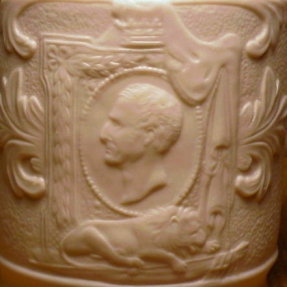
Notable men have been depicted in profile within a circular or oval format from the coins of ancient rulers, through Renaissance medals of noblemen, and down to ceramic medallions by potters like Wedgwood. A quick perusal of nineteenth century commemorative medals on the market today reveals views of Wellington at various stages of life. Our parian portrait is more generalized than most, but upon close examination we see the faint sideburns, prominent in this medal of about 1839.
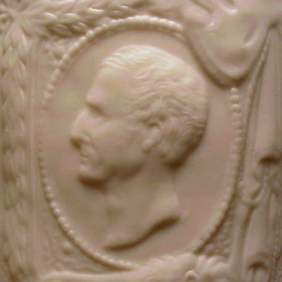
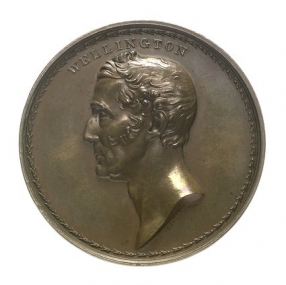
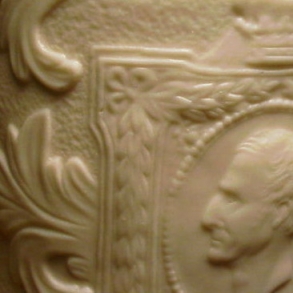
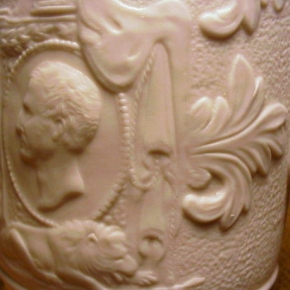
_f289x272_1336224368.jpg)
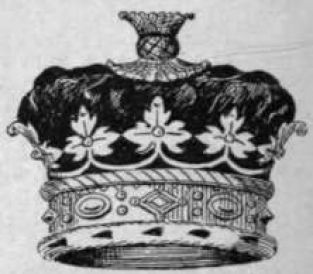
The association of the lion with great men is so traditional that it is almost intuitive. Lion heads, for example, adorn the duke's tomb in the crypt of St. Paul's. The recumbent mourning lion at the base of our portrait, however, has some distinct antecedents.
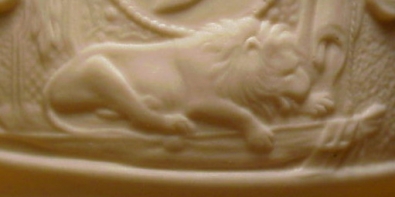
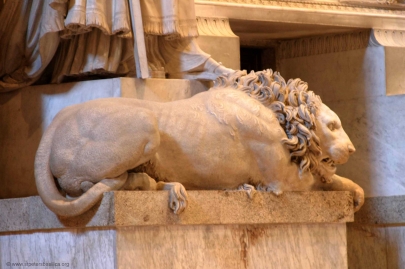
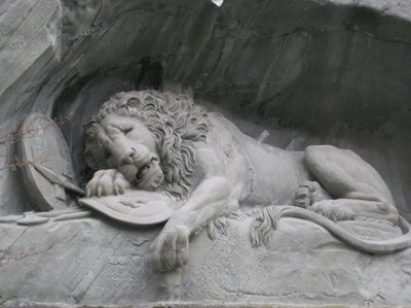
We know that to the unknown manufacturer, the passing of Wellington would have represented a commercial opportunity. If we imagine the point of view of the owner, however, we might sense a patriotic sentiment more personally felt than the elaborate grandiose presentation pieces that fill Apsley House or the slightly silly colossal statues. It expresses admiration, not only of military heroics, but of a long life of national service.
Posted By: Mark
Posted on: 2012-02-04 13:45:52
Featured Item:
Robinson Crusoe
Juvenile and ABC Wares
To launch the third year of the Seekers Journal, we could find no better topic than children’s wares, ABC plates, mugs, etc. After all isn’t collecting all about some deep seated childhood instinct centered around acquiring things to make one’s world better, prettier or more interesting?
Offerings in the Seekers Juvenile & A-B-C category almost always date from the nineteenth century. This is not to imply there were no earlier English children’s wares. We have handled eighteenth century toy pieces in salt glaze as well as porcelain by Bow and Caughley. However with the technical developments in transfer printing and firing of the late 1820’s and early 1830’s, a floodgate of children’s wares by English potters poured into the marketplace.
Victorian era children’s wares reflect a shift in attitude toward children and childhood itself. In the eighteenth century (and earlier), children were viewed as little adults. As wealth (and knowledge) became more widespread with the shift from an agrarian to an urban industrial base in the nineteenth century, attitudes toward children gradually changed. Childhood came to be viewed as a time of development. A new market in children’s wares accompanied this expansion of wealth and knowledge. Publishers generated literature directed at children which in turn created a golden age of children’s illustration. Constantly searching for new products, the Staffordshire potters soon discovered this new market and began producing wares for children on a much broader scale. Never overly fastidious regarding copyrights, these potters often appropriated the illustrations generated by the trade in children’s literature to decorate their children’s wares
With these things in mind, we are focusing on the tale of Robinson Crusoe for this month’s featured item – and the wares of two different manufacturers which share the Crusoe subject.
Bailey & Ball Juvenile Plate, “Robinson Crusoe”
Diameter: 5 ¾ in.
Dates: 1847-1850
Price: $155.00
The Brownhills “Robinson Crusoe” Alphabet Plates
-------------------Crusoe on The Raft----------------------------------Crusoe at Work
--------------------Crusoe and His Pets-----------------------------------Crusoe Finding The Footprints
------------------Crusoe Rescues Friday
Brownhills Crusoe Series Alphabet Plates
Diameter: app. 8 in.
Dates: 1890’s
Price: $295.00 each
“Crusoe Finding the Footprints” and “Cruscoe Rescues Friday” available in smaller 7in. size
Price $275.00 ea.
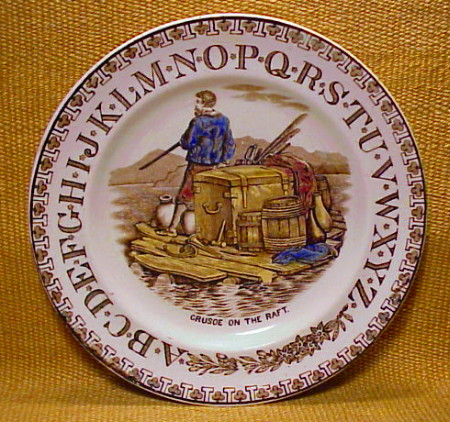 Background: The Robinson Crusoe Story
Background: The Robinson Crusoe Story
Whether one has read it or not, I think it is safe to say that everyone is familiar with some twentieth century version of the Robinson Crusoe tale. The term man (or girl) Friday is a part or our language – yet it originates in the servant-companion relationship Crusoe cultivated with the savage he rescued and called Friday. The story has been reshaped continuously since its original publication in 1719. Modern versions range from books and movies to television series as lighthearted as “Gilligan’s Island” or “Lost In Space” (“Danger Will Robinson!”).
Daniel Defoe would likely have difficulty recognizing his tale today. By trade, Defoe was a writer of Puritan guides instructing people how to be better Christians. For Defoe, the tale of Robinson Crusoe was most likely a convenient structure for the display of his dogma. Inadvertently, however Defoe stumbled on to a work with much broader appeal. Robinson Crusoe is the original castaway tale. While it has some distant roots in reality, it may be the first work of fiction based on neither myth, legend, history or a previous work of literature. (1) All castaway tales find their origins in the story of Robinson Crusoe. Far more than the religious dogma, the personal style of Crusoe’s narration--revealing his thoughts and reactions—accounts for its wide public acceptance from the beginning.
Defoe’s tale is the story of a young man’s journey into the world. Defoe builds his tale around the choices Crusoe makes in his life and the challenges (or gifts) of providence and how Crusoe manages the results of these elements to achieve the best possible life. The subtext of an alternate journey runs through Defoe’s tale following Crusoe’s development as a Christian.
Defoe’s story illustrates a belief that faith could be developed simply with the Bible in the solitude of nature (as opposed to churches filled with people listening to sermons). Defoe also illustrates the comfort and solace to be found in faith and the presence of divine providence watching over men. Conveniently, as Crusoe’s faith deepens, his life becomes better.
As the story took on a life beyond the author’s intentions in the nineteenth century, it came to be viewed in support of colonialism and the conversion and subversion of presumably ignorant natives. It was also cited among economists to demonstrate the worthlessness of currency in the absence of commerce as well as the value of tools and productivity over currency. Nineteenth century writers and publishers mined the Crusoe saga thoroughly, generating over seven hundred different editions by the end of the century – including special children’s editions which were mostly pictures. Over time, authors as diverse as Jean Jacques Rousseau (Emile; On Education, 1762), Beatrix Potter (TheTale of Little Pig Robinson, 1930) and Wilkie Collins (The Moonstone, 1868) have alluded to Crusoe underscoring its continuing widespread familiarity..
It is no wonder the Staffordshire potters could not resist the universal appeal this product offered.
When you hit on a great idea, run with it!
We only know the Bailey and Ball partnership through the remarkable blank they used on this Robinson Crusoe plate. The blank occurs with a registry mark for March 22, 1847 identifying Bailey & Ball of Longton as the potters. Geoffrey Godden lists their production dates as 1847 to 1850. (2)
While the blank is somewhat crude, it reflects the excitement occurring in the decorative arts of the 1840’s. By the mid 1830’s, a young man by the name of Owen Jones had established himself as a scholar and critic on design. A large part of his reputation lay in his call for the study and re-evaluation of Islamic architecture. In 1836, Jones commenced publication of his work Plans, Elevations, Sections and Details of the Alhambra. In his study of the Alhambra, Jones observed that pleasing design was often based on the repetition of familiar pattern. This pattern was either geometric or derived from conventional forms found in nature. This observation ran counter to the florid realism found in the products of the day.(3) We know that Jones’ work reached the Staffordshire potteries from mention of at least one subscription copy going to Minton. Bailey and Ball’s 1847 blank at least partly reflects the influence of Jones’ dictums in its concentric bands of repeated border patterns.
We have seen no items which can be attributed to the partnership other than these molded plates. Noel Riley in Gifts for Good Children, The History of Children’s China, 1790-1890 lists a seemingly random array of sizes ranging from six to eight inches in diameter. (4) (Note our example is 5 ¾ in. in diameter). As this plate demonstrates, the pieces always have two enamel stripes in various colors among the molded bands of border. The center is transfer, black or brown with color filled in by hand
And what a charming run they must have had. In addition to their Crusoe series, the subject matter we have seen depicted on this blank is diverse -- from the most wonderful camel imaginable to an elegant (if naive) depiction noted simply as “The Queen, ” to a homily on industry with beehive and inquisitive children, all carefully colored.
Riley lists fifteen different views for this Crusoe series, ten illustrated on the Bailey and Ball blank. She notes that most of the views can be traced to an 1840 French edition of Robinson Crusoe illustrated by J. J. Grandville. (5)
The contrast between the plate and the source print (6) tells us more than their similarities. Grandville’s image reflects the moody, shadowy world of the French Romantic painters. Bailey & Ball have taken no more than the basic composition, and that has been simplified to a rather crude line drawing that could be quickly enhanced with daubs of enamel applied by fairly unskilled hands. For all the novelty of their plate blank, to reach their intended audience they had to keep production inexpensive. The results exemplify the phrase still in common British usage, “cheap and cheerful.”
 The Wares: Brownhills Pottery Company
The Wares: Brownhills Pottery Company
If children’s ABC wares fascinate you, there are two routes to go; those with the alphabet picked out in raised letters around the rim and those with the alphabet printed as part of the decoration. If you fancy the latter, then it is the Brownhills potters who will make your heart sing.
Brownhills Bird series 7 ¼ in. plate and mug ------------Brownhills “Famous Places” 7 ¼ in. plate
The Brownhills pottery was in business from 1872 to 1896. They made a variety of transfer printed wares; however, most of us identify them with their hand colored, brown transfer, ivory body children’s ABC plates and mugs. The designs were offered in series of views relating to a subject of interest or educational benefit to children. The Brownhills mugs generally measure around 2 ¾ inches in both height and diameter while the alphabet plates are found in roughly six, seven and eight inch diameters. While most views are found on both seven and eight inch plates, we have noticed that those found on the smaller six inch size often seem to be unique to the size.
Brownhills identified their various series by establishing a different print and illustration layout for each. This followed the concept of the “artistic arrangement,” which stemmed from the precepts of the Aesthetic Movement. While the series subject would change from piece to piece, the “artistic” format remained the same.
Brownhills “Nations of the World” series; “Turk,”------“Japanese,”---------------------------“Wallachian”
Brownhills series include: “Nursery Tales,” “ Bible Pictures,” “ Children’s Clock,” “Famous Places,” “ Wild Animals,” “ Nations,” a series of birds, a series of domestic cattle and animals, “Little Red Riding Hood” and “Robinson Crusoe.”
--------“Nursey Tales” Series----------------------“Bible Pictures” Series--------------------“Children’s Clock” Series
Most of these series have their own distinct “artistic” format with the exception of “Robinson Crusoe,” “Red Riding Hood,” and the domestic cattle and animals. These series feature a center scene with a simple alphabet border around the flange of the plate.
We can only speculate that Brownhills may have already been sensing a change in public taste in these designs as they moved from the “artistic arrangement” to a simpler format
One additional note for collectors – possibly reflecting changes in consumerism in the later part of the nineteenth century, Brownhills marked the majority of their wares. In addition to the distinctive formats, one often finds either a registry diamond or number often with an accompanying “B.P. Co.” notation.
The Crusoe series is very simple and straightforward. We know of eight views(7) including the following shown above: “Crusoe on the Raft,” “Crusoe at Work,” “Crusoe and His Pets,” “Crusoe Finding the Footprints,” “Crusoe Rescues Friday,” and two not currently in our inventory: “Crusoe Viewing the Island”and “Crusoe Teaching Friday” (below).
There is one additional view which we do not have in our image files, “Crusoe Building the Boat,” and which we have only seen on the small six inch plate and a mug.
Research on the sources for the Brownhills views seems nonexistent at this point. We in fact wondered if they possibly produced their own designs given the quality and consistency which marks their product. However as we were researching this piece, we came across source views for both “Crusoe and His Pets,” and “Crusoe on the Raft.” Both are included among the illustrations of an 1860 edition titled The Life and Adventures of Robinson Crusoe published by Thomas Nelson & Sons, London, Edinburgh and New York. John Gilbert, a prolific Victorian painter and illustrator and member of the Royal Academy, is listed with engravings credited to Adeney and John Jackson. (8) The source engravings bear Gilbert’s cypher although the Staffordshire potters conveniently dropped it from their designs.
The sophisticated academic style of these two plates clearly contrasts with the simpler drawing and modeling of the other plates in the series, which seemingly cannot claim Gilbert as their source. Still, all demonstrate a narrative intent with details chosen to tell the tale and fascinate a youngster.
Comparison of the wares of Bailey & Ball and Brownhills, with their common Crusoe subject, provides interesting insight into changes brought about by the forty years which separate the wares.
Bailey & Ball’s Crusoe wares fall into an area of ambiguity in what we today classify as juvenile wares. They would certainly have been appropriate for children. However as Noel Riley points out, there is a fine line between children’s wares and the inexpensive souvenirs of seaside holidays and fairs (9) – carried home to decorate the dark corners of simple cottages with memories of a happy time. This market opened as the spread of railways made excursions popular. Bailey & Ball were producing wares as quickly and cheaply as possible to appeal to a broad audience. The printed images, like the fancy shape, were calculated to catch the potential buyer’s eye—one who might value the image of a popular fictional hero.
There is no doubt that Brownhills’ production was targeted for the nursery and reflects the increased understanding of and interest in childhood development in the latter Victorian era. The Crusoe series seems to have been created with boys in mind. The Crusoe saga was being re-shaped in the late nineteenth century as an inspirational tale for boys(10)--a message of self reliance especially tailored to male expectations and perhaps related to the burgeoning scouting movement. There is also an undercurrent of empire and European superiority –one that has attracted the attention of modern critics of imperialism.
The greater care with which the Brownhills plates are executed allows the scenes to be packed with detail, reflecting an increased understanding of what constitutes good children’s illustration. Effective illustration exhibits imagination of course, but also enough telling detail to advance the narrative and to keep young minds intrigued. Some details help tell the tale like Friday’s footprint barely visible among the foliage which allowed a delighted child to discover it along with Crusoe. Other elements advance the values conveyed like the kindly face of Crusoe when he encounters the native or—perhaps less fortuitously—the crudeness of Friday’s appearance. Other details are there simply to fascinate—the happy goat, the tabby and dog eyeing each other around Crusoe’s feet, the bamboo walls, jars, baskets, and other features of primitive domesticity.
Finally, we lack evidence of how Brownhill’s serial production was marketed, but we know enough about the way in which children collect to give the potters credit for a canny strategy. We can speculate that the existence of series must have at least sold a few extra plates for them. In our trade we have encountered enough adults who anxiously seek just one or two more birds for their flock of plates, or representatives for their congress of nations, or wild animals for their zoo or scenes to fill out the tale of Red Riding Hood or Crusoe to realize the strength of the motivation—in a child or adult--to complete a series.
Would that Daniel Defoe could have known just how far his little tale would go, how many faces it would assume, how much bigger it would grow than the vision of the author. . . . . . .”Danger! Danger Will Robinson!”
Later, Mark
As we look at our research for this piece, two sources especially stand out. First, Noel Riley’s Gifts for Good Children (noted in full below) is the best source we have come across for starting to understand the ambiguous bounds of children’s and souvenir/commemorative/ etc. wares. In addition to her catalog of examples, Riley’s insights into the changing marketplace, production and general selling practices in the nineteenth century provide essential background to understanding these fascinating wares.
The second source is the collection of children’s literature available through the online library services of the University of Florida. As ceramics collectors, this is an invaluable resource for tracking original source material. This resource was the key to finding the two source images for the Brownhills Crusoe plates as well as identifying John Gilbert as the original artist. The fact that such a splendid collection exists is beneficial to all interested in 18th and 19th century childhood studies. The importance of the fact that so much of the collection is accessible, page by page on line can not be emphasized too highly.
(1)English Department, Brooklyn College. “The Novel”, Adapted from A Guide to the Study of Literature: A Companion Text for Core Studies 6, Landmarks of Literature. http://academic.brooklyn.cuny.edu/english/melani/cs6/novel.html.
(2)Godden, Geoffrey A. British Pottery An Illustrated Guide. Clarkson N. Potter, Inc./ Publisher, New York 1975, p. 230.
(3)Flores, Carol A. Hrvol. Owen Jones, Design, Ornament, Architecture, and Theory In An Age of Transition. Rizzoli International Publications, Inc., New York 2006, p. 29.
(4)Riley, Noel. Gifts for Good Children, The History of Children’s China, Part 1, 1790-1890. Richard Dennis, Somerset, England 1991, p. 88-91
(5)Ibid p. 88-91.
(6)Defoe, Daniel. The Life and Adventures of Robinson Crusoe. George Routledge & Co., London. 1853, p. 73. Available From Collections, University of Florida: http://ufdc.ufl.edu/UF00072805/00001/thumbs?search=robinson+%3dcrusoe+%3dgeorge+%3droutledge . Grandville illustration originally appeared in French 1840 edition.
(7)Chalala, Mildred L. and Joseph P. A Collector’s Guide to ABC Plates, Mugs and Things. Pridemark Press, Lancaster, Pennsylvania 1980, p. 78-81.
Chalala also illustrates two plates from the Crusoe series by Brownhills in single color transfer, one in pink, the other in blue. Both are in the six inch diameter range. Views are “Crusoe Making a Boat” and “Crusoe Teaching Friday.”
(8)Defoe, Daniel. The Life and Adventures of Robinson Crusoe. T. Nelson & Sons, London, Edinburg, New York 1860, pp. 3, 176a. Available from Collections, University of Florida: http://ufdc.ufl.edu/UF00073544/00001/thumbs. Source for Gilbert illustrations.
(9) Op Cit, Riley, pp. 7-16
(10) Wilson, Paul; Eck, Michael; Sill Geoffrey. “Picturing the First Castaway: the Illustrations of Robinson Crusoe.” Exhibition Website, Special Collections and University Archives, Alexander Library, Rutgers University, New Brunswick, NJ 2004. http://www.camden.rutgers.edu/Camden/Crusoe/Pages/Goodbye.htm
« Prev
Next »













